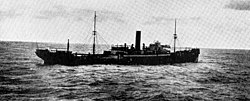SMS Leopard (auxiliary cruiser)
|
Auxiliary cruiser Leopard
|
||||||||||||||||||||
|
||||||||||||||||||||
|
||||||||||||||||||||
|
||||||||||||||||||||
|
||||||||||||||||||||
SMS Leopard was a German auxiliary cruiser in the First World War .
Technical data and history
The ship began its career as the British freight steamer Yarrowdale , which was built in 1912 at the W. Dobson & Co. shipyard in Newcastle upon Tyne and was managed by the R. Mackill & Co. in Glasgow . The Yarrowdale was launched on May 3, 1912. It was raised in the Atlantic by the German auxiliary cruiser Möve on December 11, 1916 and brought to Swinoujscie on December 31, 1916 with a prize crew . At the Imperial Shipyard in Kiel , the ship was converted into an auxiliary cruiser and then renamed the Leopard . As an auxiliary cruiser, the Leopard was armed with five 15 cm rapid fire cannons , four 8.8 cm rapid fire cannons and two 50 cm torpedo tubes . The design speed was 13 knots . The maximum travel distance was around 26,000 nautical miles at an average speed of 11 knots and 4,500 tons of bunkered coal.
Exit and sinking by British naval forces
On March 10, 1917, the auxiliary cruiser left Kiel under the command of Corvette Captain Hans von Laffert. On March 7, he received a warning from the so-called E-main office, which was tapping into British radio telegraphy traffic. After that, the British guard lines in the intended breakthrough area had been considerably strengthened by the sea blockade between Scotland and Greenland in the last few days and weeks.
The Leopard was attacked by the British armored cruiser Achilles under Captain F. M. Leake and the auxiliary cruiser Dundee under Commander Selwyn M. Day of the Royal Marine Reserve on March 16, while attempting to break the British blockade line between Norway and Iceland , northeast of the Faroe Islands posed. At that time the Leopard was wearing the mask of the Norwegian steamer Rena . There was a heavy battle in which there were no survivors on the German side. The entire 319-strong crew sank with their ship. In addition, there was a six-person prize squad from the Dundee, led by Lieutenant at Sea of the Reserve F. H. Lawson, who had gone on board before the battle to examine the Leopard .
The German admiral's staff only found out about the sinking of the ship through a message in a bottle , which was driven on June 5, 1917 in Tromsø, Norway . The text read:
- We stand between Iceland and Norway at 2 pm on March 16. Battle 64 ° 50 'north, 1 ° west longitude. Battle with an English cruiser. Fight for the fame and honor of Germany. One last greeting to our relatives.
The document was signed by some of the Leopard's deck officers . During the war, the Admiral's staff did not learn any further details about the fate of the auxiliary cruiser, as the British press kept the incident secret and the German eavesdropping service also from the British radio traffic of 16/17. March 1917 could not draw any conclusions about the sinking of the ship. It was not until a good two years later, on April 19, 1919, that the Times published the Dundee and Achilles combat reports of March 17, 1917 under the heading Official Report on the Loss of the Auxiliary Cruiser "Yarrowdale". These reports indicated that the British were except The Dundee's six-man prize squad had suffered no losses, although the battle with the Leopard lasted a good hour, and that the two British ships had left the wreckage immediately because they had sighted submarines , and that therefore no rescue attempts were made for any survivors had been.
literature
- Entry: auxiliary cruiser "Leopard" . In: Captain of the Sea a. D. Hugo von Waldeyer-Hartz: The cruiser war 1914-1918. The cruiser squadron. Emden, Koenigsberg, Karlsruhe. The auxiliary cruisers . Oldenburg i. Cit. 1931, p. 207.
- Leopard . In: Hans H. Hildebrand, Albert Röhr, Hans-Otto Steinmetz: The German warships. Biographies - a mirror of naval history from 1815 to the present , 7 volumes. Ratingen o. J. (1983), Vol. 6, p. 102.
- Chapter: SM auxiliary cruiser "Leopard" . In: Eberhard von Mantey : The German auxiliary cruisers . Berlin 1937, pp. 223-236.
- John Walter: Pirates of the Emperor - German trade troublemakers 1914-1918 . Stuttgart: Motorbuch Verlag, 1994, ISBN 3-613-01729-6 , pp. 184-185.
Web links
- Original English-language reports from naval-history.net , accessed on January 13, 2014
- Leopard at german-navy.de
- Yarrowdale at Miramar Ships Index
- The Leopard's fallen list at denkmalprojekt.org, created in 2016

